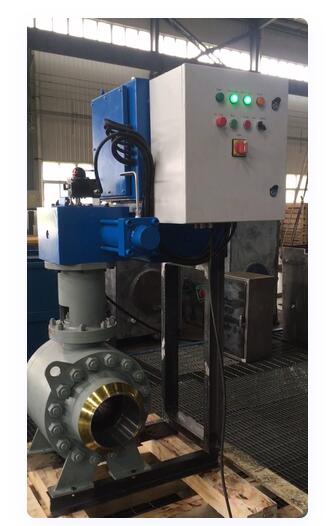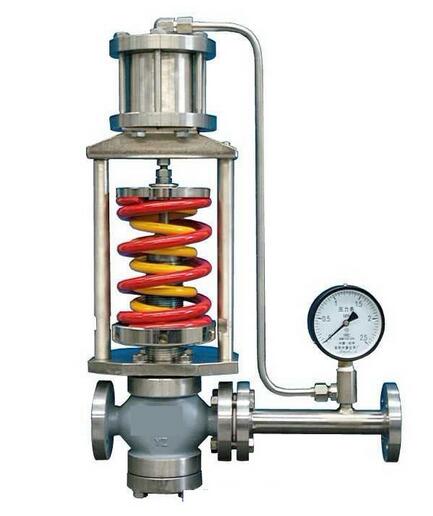Large diameter valves are essential components in industrial pipeline systems, where they play a crucial role in regulating the flow of fluids or gases. These valves are specifically designed to handle pipelines with larger diameters, typically ranging from several inches to several feet.
Industrial pipeline systems often require the use of large-diameter valves. While smaller ball valves are commonly seen and are relatively inexpensive, the dynamics change significantly when it comes to valves with larger specifications. In fact, such valves can be considered as entire systems or equipment in themselves.

One such example is the DN250 liquid-operated high-pressure ball valve depicted in the image above. This particular valve is driven by a separate hydraulic system, utilizing a rack and pinion liquid cylinder mechanism. It also incorporates simple electrical control for local and remote operation. Valves of this size find extensive application in industries such as oil, gaz, thermal power, ve kimyasallar, where their seemingly basic function of switching plays a crucial role. Hence, safety and reliability become paramount objectives for such valves.
Switching valves, küresel vanalar dahil, kelebek vana, ve sürgülü vanalar, are commonly employed in pipeline systems.
Large Diameter Ball Valve
Ball valves are known for their excellent sealing properties and high reliability. Fakat, in high-pressure conditions, the torque required to operate ball valves can be substantial and should not be overlooked. Dahası, their larger size necessitates considerations related to connection dimensions and weight.
Large Diameter Butterfly Valve
Kelebek vana, diğer taraftan, are smaller and lighter compared to ball valves. Fakat, ensuring proper sealing becomes more critical with butterfly valves, making them well-suited for low-pressure or ventilation environments. With advancements such as the triple eccentric butterfly design, these valves are also finding their way into high-pressure applications.
Large Diameter Butterfly Valve
Gate valves often evoke memories of childhood experiences with rural drainage systems. Their structure is simple yet visually impactful, relying on pulling to open or close the valve. Gate valves are known for their reliability and can handle high-pressure conditions, although my personal exposure to them has been limited.
When it comes to flow adjustment, two primary types of valves are commonly used: regulating valves and pressure reducing valves.
Regulating Valve
Regulating valves, also known as flow regulating valves or proportional throttle valves, are employed to control flow. Fakat, it is important to note that changes in flow can lead to corresponding changes in pressure, particularly when the load is not completely sealed under working conditions. In such scenarios, pressure regulation is achieved using regulating valves. The term “basınç ayar vanası” is a broad concept that encompasses various structures and functions. While the nomenclature may not accurately describe the valve’s specific structure or function, it has become a widely accepted term in the industry.
Pressure Reducing Valve
Pressure reducing valves, specifically self-acting pressure reducing valves, utilize a pressure-sensing tube at the outlet and an actuator mechanism to maintain pressure balance, ensuring a desired outlet pressure level. These valves operate similarly to what is commonly understood as pressure reducing valves in the hydraulic industry. Fakat, their pressure setting range is narrow, making adjustments less convenient. Once set, these valves are typically left unchanged for their intended working conditions.

It is worth mentioning that there are other pressure reducing valves available for specification applications that do not incorporate a feedback tube. These valves lack the ability to self-balance outlet pressure and are suitable only for scenarios with constant gas flow and consistent inlet and outlet pressures. It is crucial to choose these valves carefully, as their range of suitable working conditions is limited. In situations where outlet pressure stability is uncertain or subject to change, it is advisable to opt for self-operated pressure reducing valves.
Summary of Large Diameter Valves from Farpro
Their size, yapı, and performance characteristics make them crucial for efficient fluid control and reliable operation. Selecting the appropriate large diameter valve for a specific application requires careful consideration of factors such as size, malzemeler, actuation, and industry standards to ensure optimal performance and long-term reliability.
Sonuç olarak, the world of valves is vast and diverse, catering to a wide range of industrial needs. Understanding the differences between various valve types and their specific applications is crucial in selecting the right valve for your particular requirements.
